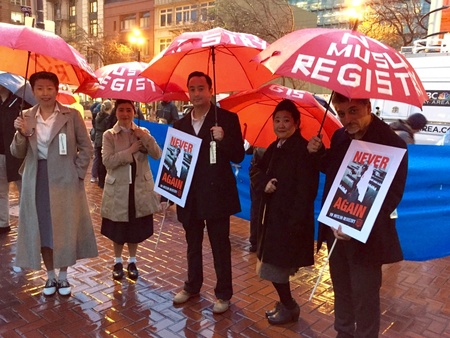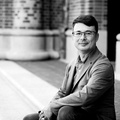For much of the 19th and 20th centuries, Buddhism was considered a threat to America. Hondo Lobley interviews scholar Duncan Williams about what we might want to remember from that time. Introduction by Funie Hsu.
* * * * *
The history of American Buddhism is a story of immigration.
Our understanding of the historical relationship between American Buddhism and immigration is obscured by a history of exclusion, white supremacy, and anti-immigrant sentiment. Today, the aggressive dismantling of protections for incarcerated non-citizen immigrants and frequent raids by Immigration and Customs Enforcement (ICE) serve as reminders that this legacy is a continued reality for many who currently reside in the U.S. It is worthwhile, then, to turn to the history of American Buddhism to recognize that previous generations of Asian and Asian American Buddhists have endured exclusion, erasure, and violence as immigrants in America and to consider what Buddhists in America today can do to support immigrant communities under attack.
The 1882 Chinese Exclusion Act was the first federal law to prohibit immigration based on ethnicity. To accommodate the demands of white labor organizations like the Workingmen’s Party of California, President Chester Arthur signed the law that curtailed Chinese immigrant labor. The Act also effectively stymied the growth of the first significant community of Buddhist practitioners in the U.S. Later, Japanese and Japanese Americans became the target of anti-Asian hostilities as their population quickly grew in the West Coast during the turn of the 20th century. As a predominantly Buddhist community, their religion was viewed as a marker of their foreignness. With the bombing of Pearl Harbor in 1941, Japanese and Japanese American Buddhists became a special threat to national security. Martial law was immediately declared in Hawai’i, and FBI agents were quick to detain Buddhist priests for questioning. Executive Order 9066 authorized the eventual mass removal of 120,000 Japanese and Japanese Americans from the West Coast and sanctioned their incarceration into concentration camps for the duration of the war.
In the interview that follows, Hondo Masato Lobley, a descendant of Japanese American Buddhists incarcerated in the Amache camp and a member of the Kaiho Collective, sits down with scholar and Soto Zen priest, Dr. Duncan Ryuken Willams, to discuss his forthcoming book on Buddhism and World War II incarceration, American Sutra: Buddhism and the World War Two Japanese American Experience. The conversation presents an exploration of American Buddhism as it pertains to the Japanese American experience and issues of immigration and American identity. As such, it provides important considerations for our contemporary climate, especially in regards to the treatment of Muslims and Muslim Americans by the current administration. It also illuminates, as Dr. Williams details, the manner in which Asian immigrant Buddhists have paved a path towards liberation that Buddhists in America walk today.
—Funie Hsu, Ph.D., Assistant Professor of American Studies,
San José State University
A note on terminology: In choosing to use the terms incarceration and concentration camp in lieu of internment/camp, we adhere to the growing consensus among scholars and activists that denotes the accuracy of the former terms in best describing the political realities and conditions of the incarceration experience.
* * * * *
Hondo Lobley: “This is not normal” has become a common liberal outcry against the Trump administration, regarding actions like the travel ban, the proposed Muslim registry, and the blatant racism of cabinet members. Your research on the racial and religious persecution of Japanese Americans during WWII highlights the fact that state-sponsored prejudice has, in fact, been normal through the course of American history. What noteworthy incidents of government-sanctioned discrimination have you come across in your research?
Duncan Williams: There’s been a very long history. It’s not that the government itself says, “Let’s figure out a policy approach to specifically target a particular race or religion.” It’s more of a broader societal conversation that involves civic leaders, local politicians, state level people, church leaders, newspapers
There’s a model of inclusion that presumes Anglo-Protestants at the center of American identity. Those at the center of this model then make decisions on how to widen the circle of inclusion. When people started talking about America as a “Christian nation,” that was a move to start including Catholics — Italians and Irish — so it wasn’t just Protestants. Being Christian covered these groups. By the time we got to Judeo-Christians, we had a moment when America began to be seen as inclusive of Jews. Right after 9/11, George Bush made a famous speech when he talked about the “Abrahamic faiths.”
These frameworks for understanding national identity inform whether something is a threat to that national identity. The presence of people with different ethnic, race, or religious identity sometimes challenges an established understanding of Americanness.
To me, what’s interesting about Buddhism and Hinduism — religions that have nothing to do with the origins of the Abrahamic faiths — is that you can’t include them that way. There’s something interesting about the way Asians disrupt the idea of what America is and what it means to include Asians in America.
Looking at the Asian and Asian American example, we can start as far back as the late 19thcentury. San Francisco newspapers would use the term “heathen Chinese” — this idea of the unchristian, uncivilized Chinese migrant worker in America, which conflated a people being not-quite-human and not-quite-Christian. In that period, those things were all very much conflated.
The Japanese American incarceration is not only about race and national origin, but the idea of the religious other. That begins earlier with South Asians. The word “Hindu” meant both a race and a religion. It pointed to a backward people that were seen as not-on-par with immigrants from Europe, who were Christian.
So, to me, government policies don’t come out of the blue. They’re discussed within these kinds of frameworks. Senator Phelan of California’s discussion, right before the 1924 Immigration Act, doesn’t actually mention that one of the primary targets is Asians — just like executive order 9066 (which precipitated the Internment) doesn’t actually say the word “Japanese.” They are smart enough to understand that there’s something slightly unconstitutional in what they’re doing, and it’s slightly un-American. But, this framework is so dominant that there’s an urge to want to protect America by protecting that idea.
Going back to “it’s not normal” — saying that is okay, because it’s a strategy of de-normalizing the dominant idea. There are ways to reinforce the dominant idea and there are ways to undercut it. Saying “it’s not normal” is one of many ways to undercut it. There were allies to Japanese Americans during WWII — attorneys from the ACLU or members of the American Friends Service Committee — who used the same language: “this is not normal.” I’m okay with people saying it, not as a historical fact, but as a strategy to de-normalize things that people say are normal. I think Trump certainly has moved some lines about what is “normal.”
In an early draft of your upcoming book, you describe the role of what is currently referred to as “fake news” in generating wartime hysteria against the Japanese and Japanese Americans during WWII. Can you talk about the significance of fake news during that period?
It was widely recognized that news media outlets reported things that were blatantly false. A week after President Roosevelt’s Executive Order 9066 announcement, in February of 1942, they reported a huge attack by the Japanese on the city of Los Angeles — 30 or 40 planes. Many newspapers reported that the local Japanese and Japanese American community aided and abetted these attackers. The attacks did not at all happen. The next day, the Secretary of the Navy had to clarify it did not happen. The newspapers ultimately said it was a rumor.
What happened was that American military personnel fired anti-aircraft artillery at something they perceived as Japanese planes. Once the artillery went up, locals panicked and thought they were under attack. This was made possible because the public was prepped by the news media of that time to think that an attack by Japan on the US mainland was quite possible and probable.
There are many other instances of that kind of reportage. What is troublesome — and potentially linked to today — is that it led to Japanese and Japanese Americans being targeted by mob violence and police arrests. One guy was trying to fix his headlights and he was arrested because they thought he was trying to signal the enemy. People were prepped to believe not only that Imperial Japan would attack, but also that Japanese Americans were ready to be traitors to their country. That was certainly fanned by the news media of the time.

A difference today is that, at that time, they didn’t have a Breitbart. They didn’t have an alternate-universe news outlet. These articles were in the mainstream press of the time. There are positives and negatives with the multiplicities of news outlets today. I think it’s quite likely that if we tracked down the people who commit violence towards Muslim Americans, we would find that the news world they live in and the Facebook groups they belong to are populated with news that is not based in reality and reinstates a paranoia about a particular ethnic group. We have seen that story run before.
To be continued...
*This article was originally published on LionsRoar.com on June 15, 2018.
© 2018 Funie Hsu; Hondo Lobley





